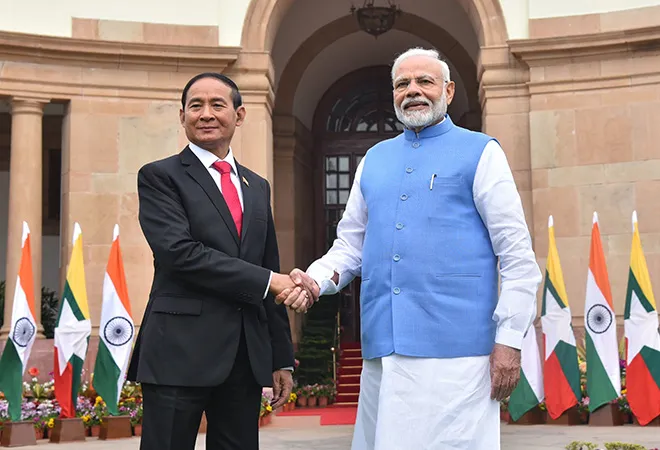Apart from the high voltage visit of the US President Donald Trump, India hosted another important Presidential visit last week. U Win Myint, President of the Republic of the Union of Myanmar and Daw Cho Cho, the First Lady paid a state visit to India from 26 to 29 February. This visit result in around 10 pacts being signed with the focus of most agreements being India aided development projects, particularly in the conflict-torn Rakhine state. The two nations also decided to work together to launch India’s RuPay Card in Myanmar at the earliest and explore the creation of a digital payment gateway as well as to explore a bilateral mechanism for settlement in local currency in order to boost cross border trade. Cooperation in the field of petroleum products, in refining, stockpiling, blending and retail has also been enhanced with greater focus on generating synergies between oil and gas companies of India and Myanmar. In a sign that the two sides are serious about enhancing connectivity, bus service between Manipur to Myanmar will be launched from April 7 this year. And at a broader regional level, the two nations agreed to work together to promote principles of openness, inclusiveness, transparency, respect for international law and ASEAN centrality in Indo pacific.
Clearly, there is a new momentum in India-Myanmar ties as India turns towards the Bay of Bengal to articulate a more ambitious ‘Neighbourhood First’ policy which links India to Southeast Asia more substantively and as Myanmar becomes a more active partner in tackling insurgents along the border. It is this recognition of Myanmar as a lynchpin in India’s ‘Act East’ policy that has made New Delhi pursue several high profile infrastructure projects including the India-Myanmar-Thailand Trilateral Highway and the Kaladan Multi-Modal Transit Transport Project, which aims to connect Kolkata with the Sittwe deep-water port in Rakhine state. Though the Sittwe port is viewed by some as a response to the Chinese-funded Kyaukphyu port, the logic of Indian footprint is much wider as New Delhi hopes for greater regional connectivity. India and Myanmar signed a landmark defence cooperation agreement in July 2019 aimed at enhancing military training, joint surveillance, and maritime security. Myanmar has been buying defence equipment from India including diesel-electric Kilo-class submarine last year.
But India is not the only player making its move in Myanmar. China as usual is much ahead in many dimensions. In January, Xi Jinping became the first Chinese leader to visit Nay Pyi Taw since 2001 to celebrate the 70th anniversary of the establishment of diplomatic relations between the two countries. He was hoping to give a fresh impetus to China’s ties with Myanmar by giving a push to a number of stalled infrastructure projects and to further enhance economic ties between the two nations. Given Beijing’s pursuit of access to the Bay of Bengal and Indian Ocean, the China Myanmar Economic Corridor (CMEC) was given a renewed push during the visit with pacts signed on railways linking southwestern China to the Indian Ocean, the Kyaukphyu deep sea-port in Rakhine, a special economic zone on the border, and a new city project in Yangon.
But Myanmar has been cautious when it comes to Chinese investments. The $3.6 billion Myitsone Dam project remains stalled and even Xi’s visit couldn’t revive as there is local opposition to this ambitious undertaking. Other projects such as the Kyaukphyu port have also been streamlined and this being an election year, Myanmar is in no hurry to relent. There is suspicion about Chinese intentions in Myanmar given Beijing’s history of supporting ethnic armed groups on Myanmar. Though China has defended Myanmar’s handling of the Rohingya on the global stage, trust is still in short supply.For India, the challenge is to ensure that a stable and economically dynamic Myanmar emerges soon and so instead of hand wringing over China’s growing clout in the country, New Delhi needs to evolve a policy response that prioritises efficient delivery of projects in a timely manner and enhancing economic and cultural connect between the two. India’s economic engagement with Myanmar leaves much to be desired and the so called Buddhist Circuit is yet to take off. India has strengths which China can only dream of which need to leveraged more effectively. India also needs to work with other like minded countries, in particular Japan, which has a strong profile in Myanmar and is playing an important role in the peace process with ethnic groups. New Delhi and Tokyo enjoy trust in Myanmar which they should deploy in helping the country develop sustainable economic infrastructure and a more effective security architecture.
It is profoundly important for India to get Myanmar right. Not only does India’s neighbourhood policy depend on it but the wider Indo-Pacific policy of India will not be able to fructify if India’s engagement with Myanmar fails to take off.
This commentary originally appeared in Mail Today.
The views expressed above belong to the author(s). ORF research and analyses now available on Telegram! Click here to access our curated content — blogs, longforms and interviews.




 PREV
PREV


